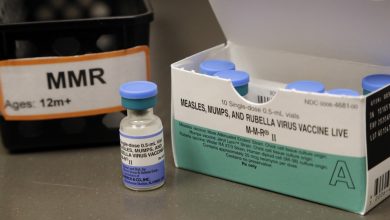Asthma: This new digital device will remind you to take your medication
الربو: سيذكرك هذا الجهاز الرقمي الجديد بتناول أدويتك
Medical News Today
Dublin: Asthma is a chronic condition affecting the airways that can cause wheezing, coughing, tightness in the chest, and shortness of breath.
An asthma attack occurs when these symptoms become severe.
About one in 13 individuals in the United States have asthma, according to the Asthma and Allergy Foundation of America.
Asthma cannot be cured but it can be treated. Individuals with asthma often carry quick-relief inhalers to use in case of an attack.
The inhalers contain medications known as bronchodilators. They relax the muscles in the lungs and widen the airways.
People with asthma are often also prescribed long-term control medications, such as Inhaled corticosteroids or leukotriene modifiersTrusted Source, which modify the production of leukotrienes. LeukotrienesTrusted Source are inflammatory molecules that are released by mast cells during an asthma attack. They are responsible for broncho-constriction.
Health practitioners sometimes prescribe oral corticosteroids for asthma flare-ups to reduce inflammation in the airways. However, oral corticosteroids cause both short and long term side-effects and risksTrusted Source, such as high blood pressure and cataracts.
Of Americans who have asthma, between 5% to 10% have severe or difficult-to-control asthma, according to the American Lung Association.
Doctors say some people with difficult-to-control asthma may not be using their inhalers correctly or using them as often as recommended.
A study led by researchers at the RCSI University of Medicine and Health Sciences looked at the use of a technological device that measures acoustic or sound-wave signals from the inhaler to objectively assesses how a person uses his or her inhaler.
The studyTrusted Source, published in The Lancet Respiratory Medicine, reported that when information from a digital device is
integrated into a clinical decision platform, then medication doses are less likely to be increased. This procedure led to a modest improvement in medication adherence among people with asthma.
Accessing biologics for asthma
Health practitioners sometimes prescribe biologics for people with severe asthma.
Biologics are part of a newer group of drugs that mimic molecules that live in cells. In people with asthma, biologics targetTrusted Source specific inflammatory pathways, reducing inflammation.
Biologics can reduce asthma flare-ups, improve lung function, and reduce the need for oral corticosteroid use. Biologics are also often expensiveTrusted Source.
About 15 years ago, Dr. Richard Costello, the lead investigator of this latest study and a professor at the RCSI University of Medicine and Health Sciences, ran a program for people with severe asthma.
“We were really restricted in access to the biologics because of costs,” he told Medical News Today.
Earlier in his career, Costello had listened to a speaker who speculated that people frequently fail to take their asthma medications correctly.
“It really stuck in my mind that if I was going to be… making decisions on a limited number of people to get a biologic, I needed to be sure that the people I was selecting were the best fit,” he explained.
About a decade ago, Costello teamed up with an engineer.
“We developed this acoustic bass device that allows us to tell both when the inhaler was used but also how it was used,” he said.
With the device, doctors could look at objective information about whether patients were using their inhalers at the frequency prescribed and using them correctly. If patients were using the inhalers as directed, health practitioners could feel more comfortable prescribing biologics.
“We think it’s kind of an equitable way to to access biologics,” Costello said.
Details from the asthma inhaler study
Researchers carried out the study in 10 severe asthma clinics in Ireland and England with 200 participants who had severe or difficult-to-control asthma.
Eligible participants had to be at least 18 years old, diagnosed with asthma and prescribed inhaled corticosteroids in combination with a twice-daily inhaled corticosteroids (ICS) long-acting beta-agonist for at least 12 months.
Within the previous year, participants also needed to have had a severe flare-up, requiring being treated with oral corticosteroids, visits to an emergency room, or admittance to a hospital.
People were excluded from the study for a number of factors, including if they were already on biologics.
Over the course of a 32-week study, participants had three nurse-led education visits and three physician-led visits where their treatment could be adjusted.
Participants in the active group used an Inhaler Compliance Assessment (INCA) device, which attached to the top of an inhaler. The device made an audio recording each time the inhaler is used.
Signal processing algorithms classified the quality of each inhalation. If the inhaler wasn’t primed, if there was an exhalation into the inhaler before inhalation, or the inhalation flow peak was less than 40 liter per minute, the algorithm marked the use as an error.
Additionally, participants recorded twice daily digital peak expiratory flow (ePEF).
Participants in the control group had adherence and exacerbations accessed by pharmacy records, health practitioners watching inhaler technique, and use of a questionnaire.
Digital approach to asthma treatments
At nurse-led education visits, participants in the active group received visual biofeedback on adherence and inhaler user error. They were also shown the relationships between treatment use and their ePEF.
During the nurse-led education visits for participants in the control group, participants heard a standard education program that included a discussion of the nature of asthma.
During the physician-led visits for participants in the active group, doctors were provided with asthma and adherence data that was factored into a decision algorithm on how to adjust treatment.
During the physician-led visits for participants in the control group, doctors relied on traditional methods such as visual assessment of inhaler technique to decide whether to adjust treatment.
Of the active group, 14% were prescribed a net increase in treatment, while 32% of the control group were prescribed a net increase in treatment.
Of the active group, 31% were able to reduce their medication. In the control group, 18% were able to do this.
Of the 102 patients in the active group, 11 needed add-on biological therapy. Of the 98 control patients, 21 needed add-on biological therapy.
Reducing treatment burden
Dr. Jimmy Johannes, a pulmonologist and critical care medicine specialist at MemorialCare Long Beach Medical Center in California who was not involved with the study, told Medical News Today that he would be interested to read future clinical trials about the INCA device.
“We’ve known to a certain degree that adherence can be a big issue with our asthma patients,” Johannes said. “But to see one, the degree that it might be an issue, and also two, how much adherence improvement can result in reducing the treatment burden and reducing the use of biologics.”
The point of creating the device, Costello pointed out, isn’t to give doctors a way to catch patients not following directions.
“We’re looking to see if we can support people,” he said. “If they’re struggling to understand about their condition or they’re struggling to use their inhaler correctly, it’s not fair to judge them as being non-adherent. It’s not fair that insurance companies put incredible barriers on people accessing biologics.”
قنا
دبلن: طور باحثون من الكلية الملكية للجراحين في أيرلندا جهازا رقميا يوفر تقييما موضوعياً لكيفية استنشاق مريض الربو لجهاز تخفيف نوبات السعال، ويراقب أيضاً مدى التزام المريض بمواعيد وكمية الدواء.
وذكرت الدراسة التي نشرها موقع “ميديكال نيوز توداي”، أن الجهاز يستخدم إشارات موجات صوتية لعمل التقييم، ويساعد بذلك في حل مشكلة عدم نجاح المرضى في كثير من الأحيان في استخدام جهاز الاستنشاق، ووصول الدواء كما هو مطلوب.
وقالت النتائج:” إن التقنية يمكن أن تساعد الأطباء في تحديد المرضى الذين سيستفيدون من هذه الأدوية البيولوجية باهظة الثمن”.
وأجرى الباحثون الدراسة في 10 عيادات ربو حادة في أيرلندا وإنجلترا بمشاركة 200 مريض يعانون من ربو حاد أو يصعب السيطرة عليه، واستخدم 102 منهم الجهاز الرقمي.
واستمرت التجربة 32 أسبوعاً، وتمت 3 زيارات تعليمية من ممرضات، و3 من أطباء، بهدف تعديل العلاج حسب الحاجة.
وصنفت خوارزميات معالجة الإشارات جودة كل استنشاق، واعتبرت الخوارزمية الاستنشاق خاطئاً إذا لم يتم تحضير الجهاز جيداً، أو إذا كان هناك زفير في جهاز الاستنشاق قبل الاستنشاق، أو كانت ذروة تدفق الاستنشاق أقل من 40 لتراً في الدقيقة.
ورصدت النتائج أن المجموعة التي استخدمت جهاز الاستنشاق الرقمي تم وصف 14 بالمئة زيادة صافية في العلاج لها، بينما وصفت 32 بالمئة زيادة صافية لمن استخدموا الجهاز التقليدي. وإجمالا تمكن 31 بالمئة من المرضى الذين استخدموا الجهاز الرقمي من تقليل أدويتهم، بينما تمكن 18 بالمئة فقط من مستخدمي الجهاز التقليدي من ذلك.




